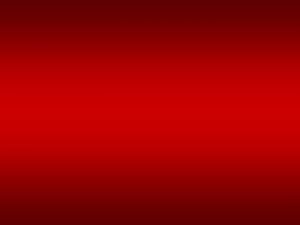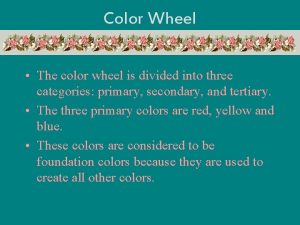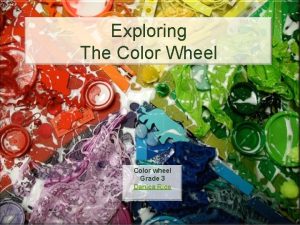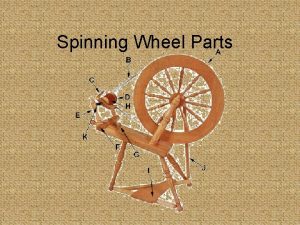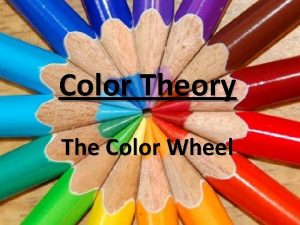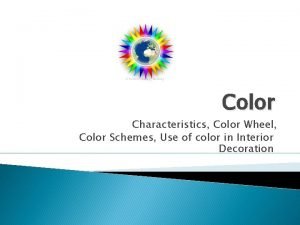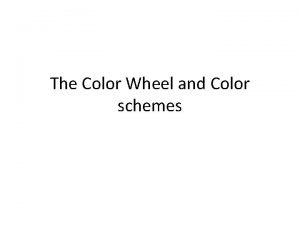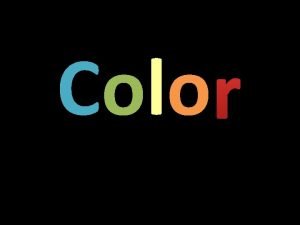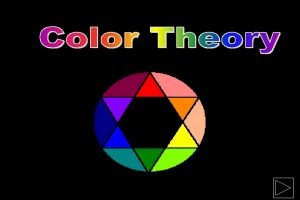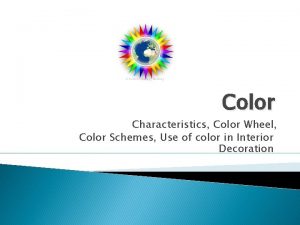The Color Wheel 1 2 COLOR All color





















- Slides: 21

The Color Wheel 1

2

COLOR • All color comes from light. • Color is light broken down in electromagnetic vibrations of various wavelengths Long wavelength Short wavelength – Longest—red – Shortest—violet 3

Pigments • Materials used for adding color to dyes and paints came from animal, mineral and vegetable products • Today, color is made by using chemistry 4

Primary Colors Red yellow blue • The foundation of all colors on the color wheel • Cannot be mixed from other pigments • Located on the points of the main, top triangle Piet Mondrian, Composition A, 1923 Oil on canvas (Galleria Nazionale d'Arte Moderna e Contemporanea, Rome Keith Haring, Untitled (Three Dancing Figures), Version A, Edition 2/3, 1989, painted aluminum. 5

Secondary colors • • Orange Green Violet Made by mixing equal amounts of two primary colors • Located on the points of the upside -down triangle, between the colors Henri Matisse. Portrait of Madam Matisse. 1905. Statens Museum for Kunst 6

Picasso Monochromatic • This painting is an example of Picassos Blue PD • This painting was created in a monochromatic blue color scheme

Analogous paintings

Analogous Color Scheme

Analogous Warm

Complimentary Color Scheme Red and Green /Warm Colors

Complimentary Color Scheme The Artist Vincent Van Gogh Painted His bedroom Using Orange and Blue And Green And Red Both are Complimentary Color Schemes

Abstraction vs Realism Simplified Abstraction This drawing shows a Realistic interpetation by The artist.

Tertiary Colors (Intermediate colors) • • • red-violet red-orange yellow-green blue-violet blue-green • Made by mixing an equal amount of a primary color and a secondary color. • (Or mix two primary colors together, adding more pigment of the primary color that the tertiary color is closest to and less pigment of the primary color that the tertiary color is farther away from. For example, Blue-violet would be made by mixing mostly blue pigment mixed with a little dot of red pigment) • ALWAYS name the primary color first before you name the secondary color. Located between the primary and secondary colors they are made from. • Josef Albers, Study to Homage to the Square: Guarded, 7 7 1958/1959.

Light & Dark Colors • Black, white and gray are not true colors (hues). They are neutral colors. Pablo Picasso, Guernica, 1937. • Value is the lightness or darkness of a color. • Black is added to make a color darker in value. A shade is made by adding black, and it is a dark color of the original hue. Maroon is a shade of red. • White is added to make a color lighter in value. A tint is made by adding white, and it is a light color of the original hue. Pink is a tint of red. Marc Chagall, Champ de mars, 1954 -55, Museum of Folkwang, Essen. 8

Monochromatic Color Scheme • Monochromatic Color Scheme: one color in different value (the lightness and darkness of a color) and intensity (the brightness or dullness of a color). • Monochromatic color scheme: any color mixed with white, gray, or black. LEE KRASNER Untitled Edition XVI-L Dye cut-out collage over lithograph, 1976. Pablo Picasso, Poor People on the Shore, 1903. 99

Analogous Colors • Analogous colors are next to each other on the color wheel. • Example: a color scheme that includes various values and intensities of yellows and oranges. Vincent van Gogh, The Night Cafe, Arles, 1888 Josef Albers, White Line Square series. Andy Warhol, Marilyn Monroe, 1962. 10

complementary colors • Colors opposite each other on the color wheel. • red & green • yellow & violet • blue & orange • You can mix two complementary colors together to make a dark, neutral color. • Complementary colors intensify each other in a piece of work. Frida Kahlo, Self Portrait with Monkey, 1940. Paul Cézanne, Manzanas, 1873 -1877. 11 Claude Monet. Rouen Cathedral, Façade, 1894. Color Study

Warm & Cool Colors • warm colors: reds, oranges, and yellows • cool colors: blues, greens and violets Paul Klee, Senecio, 1922. Romare Bearden, The Baptism, 1976, screenprint on paper, H. 38 x W. 48 inches, Courtesy of Jerald Melberg Gallery, Charlotte, NC © Romare Bearden Foundation/Licensed by VAGA, New York, NY) Keith Haring, Pop Shop Quad IV, 1989. 12

References Enchanted Learning. (2007). Color Mixing and the Color Wheel. Retrieved October 17, 2007, from http: //www. enchantedlearning. com/art/Colormixing. shtml. References in Alphabetical Order by Artists: Josef Albers: Spaightwood Galleries. (2007). Josef Albers (Germany, 1888 -America, 1976). Retrieved October 24, 2007, from http: //www. spaightwoodgalleries. com/Pages/Albers. html. Bildindex der Kunst und Architektur. (2000). Josef Albers. Retrieved October 24, 2007, from http: //www. bildindex. de/html. Romare Beardon: Traditional Fine Arts Organization. (2005). Romare Bearden: Enchanter in Time. Retrieved October 17, 2007, from http: //www. tfaoi. com/aa/6 aa 133. htm. Marc Chagall: Les Conceptions MARVAL. Marc Chagall: “Champs de Mars” 1954 -1955. Retrieved October 24, 2007, from http: //www. photosmarval. org/peintres/cubisme/marc-chagall-06. shtml. Paul Cézanne: El Ángel Caído. Manzanas. Retrieved October 24, 2007, from http: //www. elangelcaido. org/creacion/028 manzanas. html

Keith Haring: The Moscone Center. (2005). Keith Haring. Retrieved October 24, 2007, from http: //www. moscone. com/community/benefit/images/Keith. Haring 1_s. jpg. DJT Fine Art. (2000). Keith Haring Pop Shop Quad IV Silkscreen. Retrieved October 24, 2007, from http: //www. djtfa. com/cgi-bin/art/gallery. cgi? category=Haring&item=haring 005&type=gallery. Paul Klee: Oga’s Gallery. (2007). Paul Klee. Retrieved October 24, 2007, from http: //www. abcgallery. com. Lee Krasner: Vered Gallery. Lee Krasner. Retrieved October 24, 2007, from http: //www. veredart. com/. Henri Matisse: Olga’s Gallery. (2007). Henri Matisse. Retrieved October 24, 2007, from http: //www. abcgallery. com/M/matisse. html. Piet Mondrian: Witcombe, L. C. E. (2000). Modernism. Retrieved October 24, 2007, from http: //witcombe. sbc. edu/modernism/artsake. html. Claude Monet: Virginia Museum of Fine Arts. (2001). What’s New: Monet’s “Rouen Cathedral, Façade” is now on view at Virginia Museum. Retrieved October 24, 2007, from http: //www. vmfa. state. va. us/monet_rouen. html. Pablo Picasso: TLPJ. org. Pablo Picasso Poor People. Retrieved October 24, 2007, from http: //www. tlpj. org/images/news/pablo_picasso_poor_people. jpg Andy Warhol: University of Virginia Library. (2007). Gallery of American Art: Andy Warhol, "Marilyn Monroe" (1962). Retrieved October 24, 2007, from http: //etext. lib. virginia. edu/railton/enam 312/gallerys/amart 15 a. html
 Draw three noncollinear points j k and l
Draw three noncollinear points j k and l Tire wheel and wheel bearing fundamentals
Tire wheel and wheel bearing fundamentals Chapter 73 tire wheel and wheel bearing fundamentals
Chapter 73 tire wheel and wheel bearing fundamentals Holds the head of the machine
Holds the head of the machine Snub braking
Snub braking Tire safety presentation
Tire safety presentation Hình ảnh bộ gõ cơ thể búng tay
Hình ảnh bộ gõ cơ thể búng tay Bổ thể
Bổ thể Tỉ lệ cơ thể trẻ em
Tỉ lệ cơ thể trẻ em Voi kéo gỗ như thế nào
Voi kéo gỗ như thế nào Chụp tư thế worms-breton
Chụp tư thế worms-breton Chúa yêu trần thế
Chúa yêu trần thế Môn thể thao bắt đầu bằng từ đua
Môn thể thao bắt đầu bằng từ đua Thế nào là hệ số cao nhất
Thế nào là hệ số cao nhất Các châu lục và đại dương trên thế giới
Các châu lục và đại dương trên thế giới Công thức tính thế năng
Công thức tính thế năng Trời xanh đây là của chúng ta thể thơ
Trời xanh đây là của chúng ta thể thơ Cách giải mật thư tọa độ
Cách giải mật thư tọa độ Làm thế nào để 102-1=99
Làm thế nào để 102-1=99 Phản ứng thế ankan
Phản ứng thế ankan Các châu lục và đại dương trên thế giới
Các châu lục và đại dương trên thế giới





















